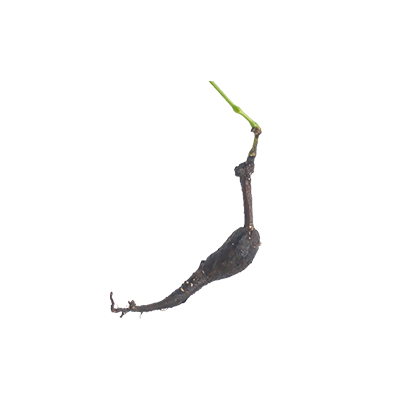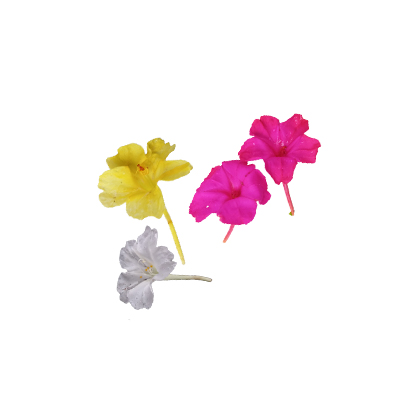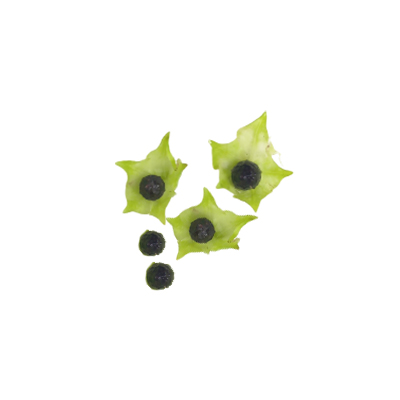Four O'clock Flower
Mirabilis jalapa L.
Nyctaginaceae
Location in our garden
Vegetable
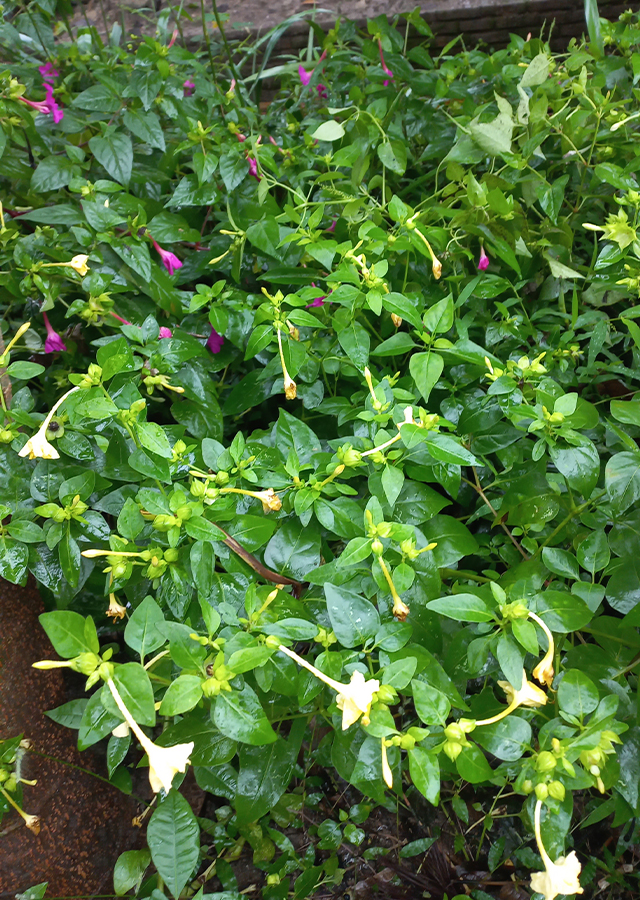

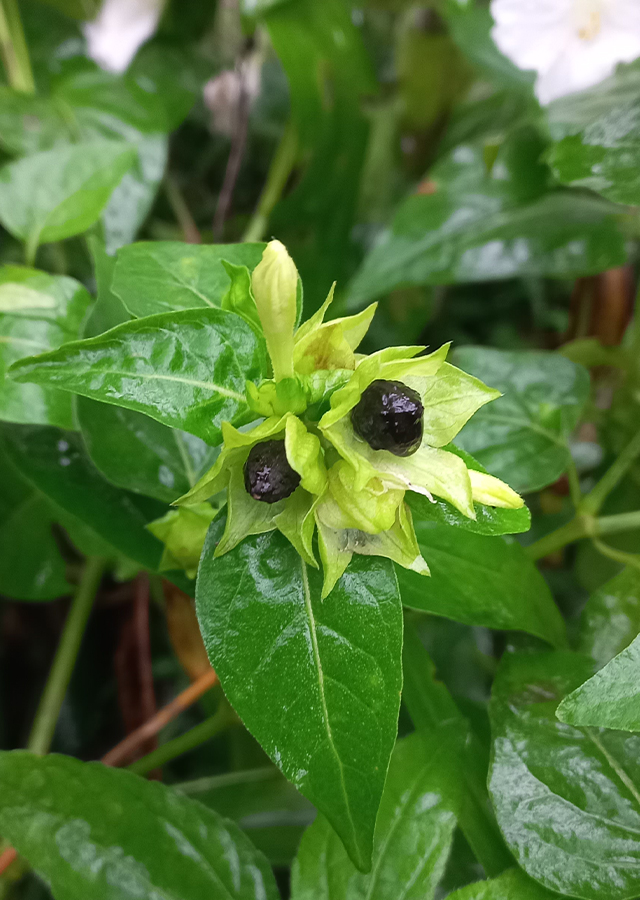
Synonym
Mirabilis jalapa f. eujalapa Heimerl
Nyctago hortensis Dum.Cours.
Nyctago jalapae (L.) DC.
Habitus
Herbaceous. Herbaceous, perennial, but used as an annual in temperate climates, up to 1 m high
Part Used
Leaves
Seeds
Flowers
Fruit
Roots
Tuber
The Whole Plant
Growing Requirements
Full Sunshine
Need Shade
Drought Resistant
Habitat
Forest
Roadside
Shrublands
Overview
The four o'clock flower or Mirabilis jalapa is a flowering plant that comes from the Nyctaginaceae family which is thought to have originated from Mexico to Central America. This species also occurs in North America, Central America, the Caribbean, South America, Europe, Africa, Asia and Oceania. This species has been introduced to various continents and cultivated as an ornamental plant since the 1500s. M. jalapa also has various other functions in society, including as a source of coloring for cosmetics, cakes and jellies, cosmetic powder, beads, medicinal plants, vegetables, spices. Where, the leaves can be eaten and used as emergency food, also the seeds are used as a substitute for pepper. As a medicinal plant, M. jalapa has also been widely used in several countries as a traditional medicinal ingredient which is believed to be able to overcome various disease complaints. This species is listed as invasive in Asia (China, Indonesia, Maldives, Philippines), Africa (Kenya, Seychelles, South Africa, Uganda), South America (Chile, Ecuador) and Oceania (Cook Islands, Federated States of Micronesia, Fiji, Hawaii- USA, Kiribati, Nauru, New Caledonia, New Zealand, Niue, Pitcairn, Tonga, US Minor Outlying Islands).
Vernacular Names
Buenas tardes (Spanish), Belle de nuit (French), Zi mo li (Chinese), Jalapa verdadeira (Portuguese), Wunderblume (German), Deilino (Greece).
Agroecology
The original habitat of M. jalapa is believed to be on forest edges, shrubs and grasslands. This species is also commonly found growing in waste soil, disturbed locations, roadsides, abandoned fields, and railroads. Found at altitudes from near sea level to 3000 m above sea level. M. jalapa can grow in almost any type of soil, as long as it is fertile, well-drained, in full sun (6 - 8 hours of sunlight) to partial shade, with soil acidity (pH) of 6.1 to 7.8. M. jalapa is also tolerant to salt and drought.
Morphology
- Roots - tap root, tuberous (bulbed), black or black-brown.
- Stems - erect, much branched, cylindrical, glabrous or slightly pubescent, bulging at nodes.
- Leaves - unifoliate, arranged opposite, ovate or ovatetriangular. Leaf base truncated or heart-shaped (cordate), flat leaf edges, pointed leaf tips (acuminate), pinnate venation. Petiole about 1-4 cm.
- Flowers - usually clustered at the top of the branches, arranged in 3-7 clusters, trumpet-shaped, lemon-scented. Involucre campanulate, 5-lobed, triangular-ovate lobes, pointed, glabrous. Perianth (floral ornaments) of various colors (purple, red, yellow, white, or variegated), tubular, open in the evening and close the next morning. Stamens are 5 in number, slender filaments, anthers are globose.
- Fruits - dry, dark brown to black, narrow ovate, 5-8 mm in diameter, seed-like, ribbed, wrinkled and layered. White starchy endosperm.
Cultivation
- Propagated by seeds, tubers and stem cuttings.
- Although the flowers are morphologically adapted for crossing, this species is reported to be mostly selfer. This species can self-pollinate by rolling the stamens toward the stigma when the flower closes.
Chemical Constituents
Oxymethylanthroquinone, trigonelline, galactose, arabinose, steroids, tannins, saponins, inulin, flavonoids, glycosides, triterpenoids, chrysophanol, physcion, stigmasterol, mirabijalone A, boeravinone C, aurantiamide acetate, glycerin monoeicosate, β-sitosterol, 4-hydroxy-3- methoxybenzoic acid, astragaloside II, astragaloside II, astragaloside IV, astragaloside VI, flazin, 4'-hydroxybenzaldehyd, 3-dihydroflavone 7-beta-D-glucopyranoside, gingerglycolipid A, 3, 4-dihydroxybenzaldehyd, p-hydroxybenzaldehyde, beta- sitosterol, daucosterol, phenolic compounds (hydroxycinnamic acids, isoflavonoids, coumarins).
Traditional Medicinal Uses
- Whole plant extensively used for muscular pain, diarrhea, and abdominal colic.
- Plant decoction taken orally for diuresis in kidney infections.
- Infusion of leaves applied topically to reduce swelling in bone fractures and swelling. Also used as a diuretic and for dropsy.
- Roots used for syphilitic sores; also as aphrodisiac, mild purgative, emetic and cathartic.
- Tubers used for treatment of piles.
- Fruit paste mixed with coconut oil applied externally for relief of headache.
- Juice of leaves are soothing when applied to areas of urticaria and used internally for gonorrhea.
- In India and Java bruised leaves used as poultices for boils and abscesses, and the juice used for uterine discharges.
- Leaves are anti-inflammatory. Decoction used for abscesses.
- In China and the Himalayas, used in traditional medicine in treatment of diabetes.
- In Peru and Nigeria, root decoction used as diuretic.
- In India and Java, bruised leaves used for poulticing boils and abscesses; juice used for uterine discharges.
- In Brazil, Kayapo indians inhale the powdered dried flowers for headaches; the Assurani Indians grate the tuberous seeds and drink it for intestinal parasites. Poultice of leaves and flowers used for eczema, skin infections and itching.
- In south Brazil, infusion or decoction of leaves used to treat inflammatory and painful diseases; also used as laxative.
- In Mexico, the decoction of entire plant is used vaginal discharge, dysentery, diarrhea, abdominal colic and muscle pains.
- In Thailand, seed powder used for infections.
- In South Africa, used as a purgative.
Part Used
Reference Sources
- Royal Botanic gardens, Kew. Plants of the World Online: Mirabilis jalapa L.. https://powo.science.kew.org/taxon/urn:lsid:ipni.org:names:162591-2. 09-12-22.
- CABI. 2022. Mirabilis jalapa (four o'clock flower). https://www.cabidigitallibrary.org/doi/10.1079/cabicompendium.34254. 09-12-22.
- Stuartxchange. 2021. Philippine Medicinal Plants: A las cuatro. http://www.stuartxchange.org/AlasCuatro.html. 09-12-22.
- Flora Fauna Web. 2022. Mirabilis jalapa L.. https://www.nparks.gov.sg/florafaunaweb/flora/2/2/2227. 09-12-22.

